Optimization of Water Injection Strategy before Re-Stimulation Considering Fractures Propagation
Abstract
:1. Introduction
2. Methods
2.1. Model Description
2.2. History Match
3. Results and Discussion
3.1. 1st Year
3.2. 4th Year
4. Conclusions
Supplementary Materials
Author Contributions
Funding
Conflicts of Interest
References
- Miller, G.; Lindsay, G.; Baihly, H.; Xu, T. Parent well refracturing: Economic safety nets in an uneconomic market. In Proceedings of the SPE Low Perm Symposium, Denver, CO, USA, 5–6 May 2016. [Google Scholar] [CrossRef]
- Daneshy, A. Analysis of horizontal well fracture interactions, and completion steps for reducing the resulting production interference. In Proceedings of the SPE Annual Technical Conference and Exhibition, Dallas, TX, USA, 24–26 September 2018. [Google Scholar] [CrossRef]
- Abivin, P.; Vidma, K.; Xu, T.; Boumessouer, W.; Bailhy, J.; Ejofodomi, E.; Sharma, A.; Menasria, S.; Sergey, M. Data analytics approach to frac hit characterization in unconventional plays: Application to Williston Basin. In Proceedings of the International Petroleum Technology Conference, Dhahran, Kingdom of Saudi Arabia, 13–15 January 2020. [Google Scholar] [CrossRef]
- King, G.; Rainbolt, M.; Swanson, C. Frac hit induced production losses: Evaluating root causes, damage location, possible prevention methods and success of remedial treatments. In Proceedings of the SPE Annual Technical Conference and Exhibition, San Antonio, TX, USA, 9–11 October 2017. [Google Scholar] [CrossRef]
- Ajani, A.; Kelkar, M. Interference study in shale plays. In Proceedings of the SPE Hydraulic Fracturing Technology Conference, The Woodlands, TX, USA, 6–8 February 2012. [Google Scholar] [CrossRef]
- Rassenfoss, S. Rethinking fracturing: The problems with bigger fracs in tighter spaces. J. Pet. Technol. 2017, 69, 28–34. [Google Scholar] [CrossRef]
- Daneshy, A.; King, G. Horizontal well frac-driven interactions: Types, consequences, and damage mitigation. J. Pet. Technol. 2019, 71, 45–47. [Google Scholar] [CrossRef]
- Fisher, M.; Wright, C.; Davidson, B.; Goodwin, A.; Fielder, E.; Buckler, W.; Steinsberger, N. Integrating fracture mapping technologies to optimize stimulations in the Barnett Shale. In Proceedings of the SPE Annual Technical Conference and Exhibition, San Antonio, TX, USA, 29 September–2 October 2002. [Google Scholar] [CrossRef]
- Fisher, M.; Heinze, J.; Harris, C.; Davidson, B.; Wright, C.; Dunn, K. Optimizing horizontal completion techniques in the Barnett Shale using microseismic fracture mapping. In Proceedings of the SPE Annual Technical Conference and Exhibition, Houston, TX, USA 26–29 September 2004. [Google Scholar] [CrossRef]
- Courtier, J.; Gray, D.; Smith, M.; Stegent, N.; Carmichael, J.; Hassan, M.; Ciezobka, J. Legacy well protection refrac mitigates offset well completion communications in joint industry project. In Proceedings of the SPE Liquids-Rich Basins Conference–North America, Midland, TX, USA, 21–22 September 2016. [Google Scholar] [CrossRef]
- Cipolla, C.; Motiee, M.; Aicha, K. Integrating microseismic, geomechanics, hydraulic fracture modeling, and reservoir simulation to characterize parent well depletion and infill well performance in the Bakken. In Proceedings of the SPE/AAPG/SEG Unconventional Resources Technology Conference, Houston, TX, USA, 23–25 July 2018. [Google Scholar] [CrossRef] [Green Version]
- Chittenden, H.; Cannon, D.; Jeziorski, K.; Bowman-Young, S.; Lindsay, S. Understanding the role of well sequencing in managing reservoir stress response in the permian: Implications for child-well completions using high-resolution microseismic analysis. In Proceedings of the SPE Hydraulic Fracturing Technology Conference and Exhibition, The Woodlands, TX, USA, 31 January–2 February 2020. [Google Scholar] [CrossRef]
- Ajisafe, F.; Solovyeva, I.; Morales, A.; Ejofodomi, E.; Matteo, M. Impact of well spacing and interference on production performance in unconventional reservoirs, Permian Basin. In Proceedings of the SPE/AAPG/SEG Unconventional Resources Technology Conference, Austin, TX, USA, 20–22 July 2017. [Google Scholar] [CrossRef]
- Jacobs, T. What is really happening when parent and child wells interact? J. Pet. Technol. 2021, 73, 28–31. [Google Scholar] [CrossRef]
- Shahri, M.; Tucker, A.; Rice, C.; Lathrop, Z.; Ratcliff, D.; McClure, M.; Fowler, G. High fidelity fibre-optic observations and resultant fracture modeling in support of planarity. In Proceedings of the SPE Hydraulic Fracturing Technology Conference and Exhibition, Virtual, 4–6 May 2021. [Google Scholar] [CrossRef]
- Rainbolt, M.; Jacey, E. Frac hit induced production losses: Evaluating root causes, damage location, possible prevention methods and success of remediation treatments, Part II. In Proceedings of the SPE Hydraulic Fracturing Technology Conference and Exhibition, The Woodlands, TX, USA, 23–25 January 2018. [Google Scholar] [CrossRef]
- Joslin, K.; Ranjbar, E.; Shahamat, S.; Kiran, S. Pressure sink mitigation: Effect of preloading parent wells to better control infill hydraulic fracture propagation. In Proceedings of the SPE Canada Unconventional Resources Conference, Virtual, 28 September–2 October 2020. [Google Scholar] [CrossRef]
- Yu, W.; Wu, K.; Zuo, L.; Tan, X.; Ruud, W. Physical models for inter-well interference in shale reservoirs: Relative impacts of fracture hits and matrix permeability. In Proceedings of the SPE/AAPG/SEG Unconventional Resources Technology Conference, San Antonio, TX, USA, 1–3 August 2016. [Google Scholar] [CrossRef] [Green Version]
- Ratcliff, D.; McClure, M.; Fowler, G.; Elliot, B.; Austin, Q. Modelling of parent child well interactions. In Proceedings of the SPE Hydraulic Fracturing Technology Conference and Exhibition, The Woodlands, TX, USA, 31 January–2 February 2022. [Google Scholar] [CrossRef]
- Fowler, G.; Ratcliff, D.; Mark, M. Modeling frac hits: Mechanisms for damage versus uplift. In Proceedings of the International Petroleum Technology Conference, Riyadh, Saudi Arabia, 21–23 February 2022. [Google Scholar] [CrossRef]
- Wang, L.; Du, X.; Qiu, K.; Wu, S.; Zhuang, X.; Bai, X.; Wang, L.; Pan, Y. Frac hit in complex tight oil reservoir in ordos basin: The challenges, the root causes and the cure. In Proceedings of the SPE Annual Technical Conference and Exhibition, Virtual, 21–22 October 2020. [Google Scholar] [CrossRef]
- Vincent, M. Restimulation of unconventional reservoirs: When are refracs beneficial? J. Can. Pet. Technol. 2011, 50, 36–52. [Google Scholar] [CrossRef]
- Bommer, P.; Bayne, M.A. Active well defense in the Bakken: Case study of a ten-well frac defense project, McKenzie County, ND. In Proceedings of the SPE Hydraulic Fracturing Technology Conference and Exhibition, The Woodlands, TX, USA, 23–25 January 2018. [Google Scholar] [CrossRef]
- Whitfield, T.; Watkins, M.; Dickinson, L.J. Pre-loads: Successful mitigation of damaging frac hits in the Eagle Ford. In Proceedings of the SPE Annual Technical Conference and Exhibition, Dallas, TX, USA, 24–26 September 2018. [Google Scholar] [CrossRef]
- Gala, D.P.; Manchanda, R.; Sharma, M. Modeling of fluid injection in depleted parent wells to minimize damage due to frac-hits. In Proceedings of the SPE/AAPG/SEG Unconventional Resources Technology Conference, Houston, TX, USA, 23–25 July 2018. [Google Scholar] [CrossRef]
- Singh, V.; Roussel, N.P.; Sharma, M. Stress reorientation around horizontal wells. In Proceedings of the SPE Annual Technical Conference and Exhibition, Denver, CO, USA, 21–24 September 2008. [Google Scholar] [CrossRef]
- Safari, R.; Lewis, R.; Ma, X.; Mutlu, U.; Ghassemi, A. Infill-well fracturing optimization in tightly spaced horizontal wells. SPE J. 2017, 22, 582–595. [Google Scholar] [CrossRef]
- Guo, X.; Wu, K.; Cheng, A.; Tang, J.; Killough, J. Numerical investigation of effects of subsequent parent-well injection on interwell fracturing interference using reservoir-geomechanics-fracturing modeling. SPE J. 2019, 24, 1884–1902. [Google Scholar] [CrossRef]
- Li, N.; Wu, K.; Killough, J. Numerical investigation of key factors on successful subsequent parent well water injection to mitigate parent-infill well interference. In Proceedings of the SPE/AAPG/SEG Unconventional Resources Technology Conference, Denver, CO, USA, 22–24 July 2019. [Google Scholar] [CrossRef]
- Zheng, S.; Manchanda, R.; Gala, D.; Mukul, S. Preloading depleted parent wells to avoid fracture hits: Some important design considerations. SPE Drill Completion 2021, 36, 170–187. [Google Scholar] [CrossRef]
- Garza, M.; Baumbach, J.; Prosser, J.; Pettigrew, S.; Elvig, K. An Eagle Ford case study: Improving an infill well completion through optimized refracturing treatment of the offset parent wells. In Proceedings of the SPE Hydraulic Fracturing Technology Conference and Exhibition, The Woodlands, TX, USA, February 2019. [Google Scholar] [CrossRef]
- Gupta, J.; Zielonka, M.; Albert, R.; El-Rabaa, W.; Burnham, H.; Nancy, H. Integrated methodology for optimizing development of unconventional gas resources. In Proceedings of the SPE Hydraulic Fracturing Technology Conference, The Woodlands, TX, USA, 10 February 2012. [Google Scholar] [CrossRef]
- Xu, L.; Ogle, J.; Collier, T. Fracture hit mitigation through surfactant-based treatment fluids in parent wells. In Proceedings of the SPE Liquids-Rich Basins Conference—North America, Odessa, TX, USA, 7–8 November 2019. [Google Scholar] [CrossRef]
- Telmadarreie, A.; Li, S.; Bryant, S. Effective pressure maintenance and fluid leak-off management using nanoparticle-based foam. In Proceedings of the SPE Canadian Energy Technology Conference, Calgary, AL, Canada, 16–17 March 2022. [Google Scholar] [CrossRef]
- Cedeno, M. Unloading frac hits in gas wells: How does the nitrogen injection rate and pressure affect the unloading process? In Proceedings of the SPE Trinidad and Tobago Section Energy Resources Conference, Virtual, 28–30 June 2021. [Google Scholar] [CrossRef]
- Rasheed, M.; Shihab, S.; Sabah, O. An investigation of the structural, electrical and optical properties of graphene-oxide thin films using different solvents. J. Phys. Conf. Ser. 2021, 1795, 012052. [Google Scholar] [CrossRef]
- Abbas, M.; Rasheed, M. Solid state reaction synthesis and characterization of Cu doped TiO2 nanomaterials. J. Phys. Conf. Ser. 2021, 1795, 012059. [Google Scholar] [CrossRef]
- Kumar, D.; Ghassemi, A. Geomechanical controls on frac-hits. In Proceedings of the SPE International Hydraulic Fracturing Technology Conference & Exhibition, Muscat, Oman, 11–13 January 2022. [Google Scholar] [CrossRef]
- Haghighat, A.; Ewert, J. Child/Parent Well interactions; study the solutions to prevent frac-hits. In Proceedings of the SPE Canadian Energy Technology Conference, Calgary, AB, Canada, 15–16 March 2022. [Google Scholar] [CrossRef]
- Xiang, H. Refracturing practice of tight oil reservoirs in Ma 56 Block, the Santanghu Basin. Spec. Oil Gas Reserv. 2017, 24, 157–160. [Google Scholar] [CrossRef]
- Sui, Y.; Liu, D.; Liu, J.; Jiang, M.; Liu, J.; Zhang, N. A new low-cost refracturing method of horizontal well suitable for tight oil reservoirs: A case study on Ma 56 Block in Tuha Oilfield. Oil Drill. Prod. Technol. 2018, 40, 369–374. [Google Scholar] [CrossRef]
- Ren, G.; Ma, X.; Zhang, S.; Zou, Y. Optimization of water injection strategy before re-fracturing. In Proceedings of the ARMA/DGS/SEG 2nd International Geomechanics Symposium, Virtual, 1–4 November 2021. [Google Scholar]
- Weng, X.; Kresse, O.; Cohen, C.; Wu, R.; Gu, H. Modeling of hydraulic-fracture-network propagation in a naturally fractured formation. SPE Prod. Oper. 2011, 26, 368–380. [Google Scholar] [CrossRef]
- Nolte, K. Fracturing-pressure analysis for nonideal behavior. J. Pet. Technol. 2011, 43, 210–218. [Google Scholar] [CrossRef]
- Zhu, H.; Song, Y.; Tang, X. Research progress on 4-dimensional stress evolution and complex fracture propagation of infill wells in shale gas reservoirs. Pet. Sci. Bull. 2021, 6, 396–416. [Google Scholar] [CrossRef]
- Lewis, R.W.; Sukirman, Y. Finite element modelling for simulating the surface subsidence above a compacting hydrocarbon reservoir. Int. J. Numer. Anal. Methods Geomech. 1994, 18, 619–639. [Google Scholar] [CrossRef]
- Gutierrez, M. Fully coupled analysis of reservoir compaction and subsidence. In Proceedings of the European Petroleum Conference, London, UK, 25–27 October 1994. [Google Scholar] [CrossRef]
- Settari, A.; Walters, D.; Behie, G. Reservoir geomechanics: New approach to reservoir engineering analysis. In Proceedings of the Technical Meeting/Petroleum Conference of The South Saskatchewan Section, Regina, 15–17 October 1999. [Google Scholar] [CrossRef]
- Chin, L.; Thomas, L.; Sylte, J.; Pierson, R. Iterative coupled analysis of geomechanics and fluid flow for rock compaction in reservoir simulation. Oil Gas Sci. Technol. 2002, 57, 485–497. [Google Scholar] [CrossRef]
- Fung, L.; Buchanan, L.; Wan, R. Couplled geomechanical-thermal simulation for deforming heavy-oil reservoirs. J. Can. Pet. Technol. 1994, 33. [Google Scholar] [CrossRef]
- Koutsabeloulis, N.; Hope, S. “Coupled” stress/fluid/thermal multi-phase reservoir simulation studies incorporating rock mechanics. In Proceedings of the SPE/ISRM Rock Mechanics in Petroleum Engineering, Trondheim, Norway, 8–10 July 1998. [Google Scholar] [CrossRef]
- Minkoff, S.; Stone, C.; Arguello, J.; Bryant, S.; Eaton, J. Staggered in time coupling of reservoir flow simulation and geomechanical deformation: Step 1-one-way coupling. In Proceedings of the Annual Simulation Symposium, Houston, TX, USA, 3–6 October 1999. [Google Scholar] [CrossRef]
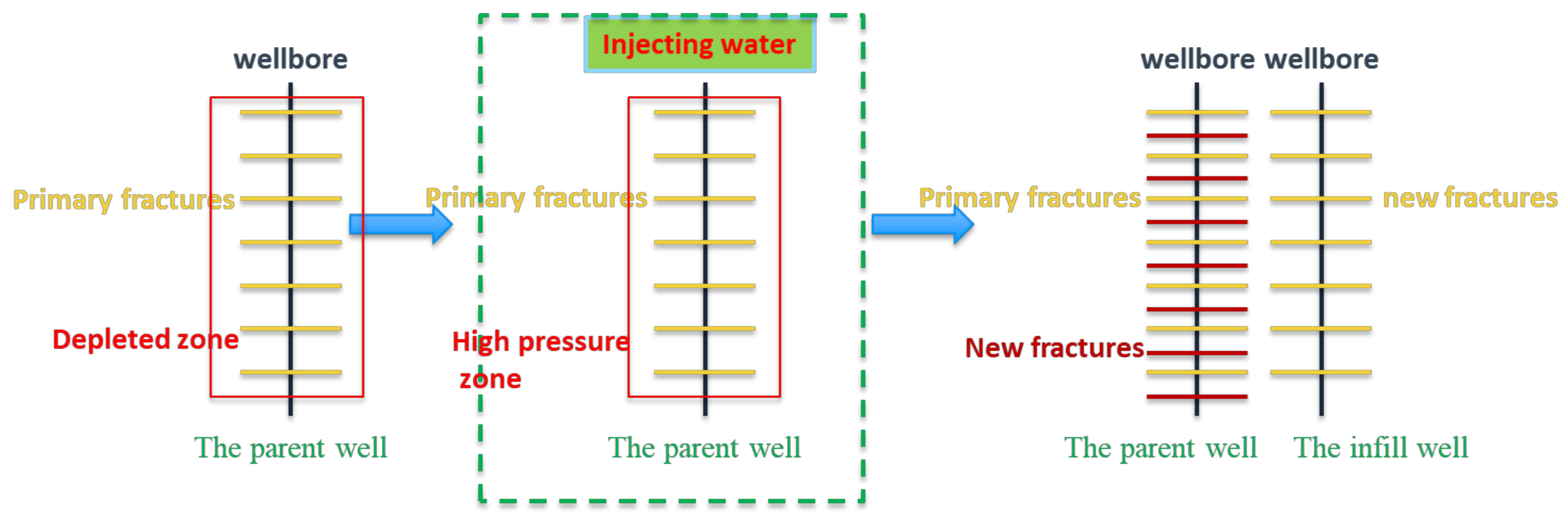
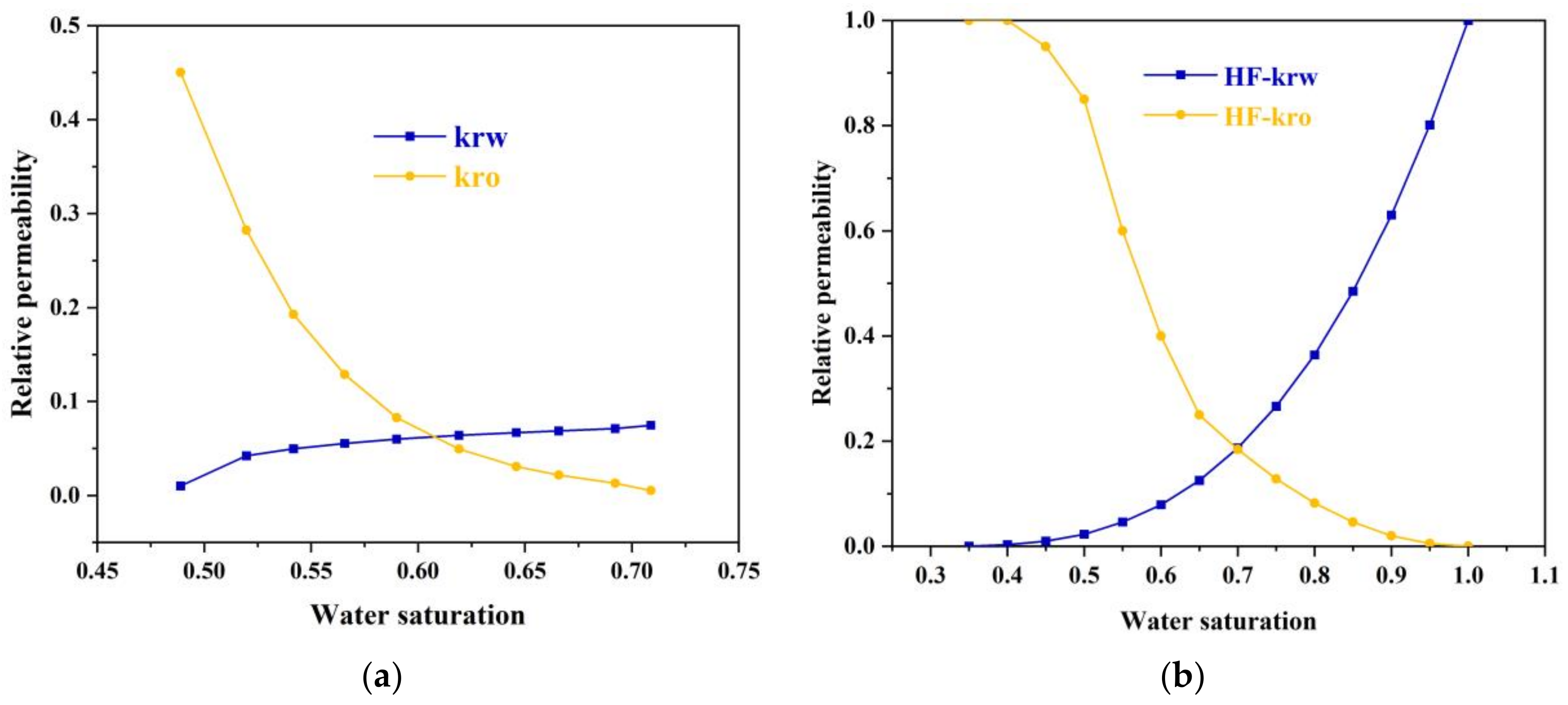


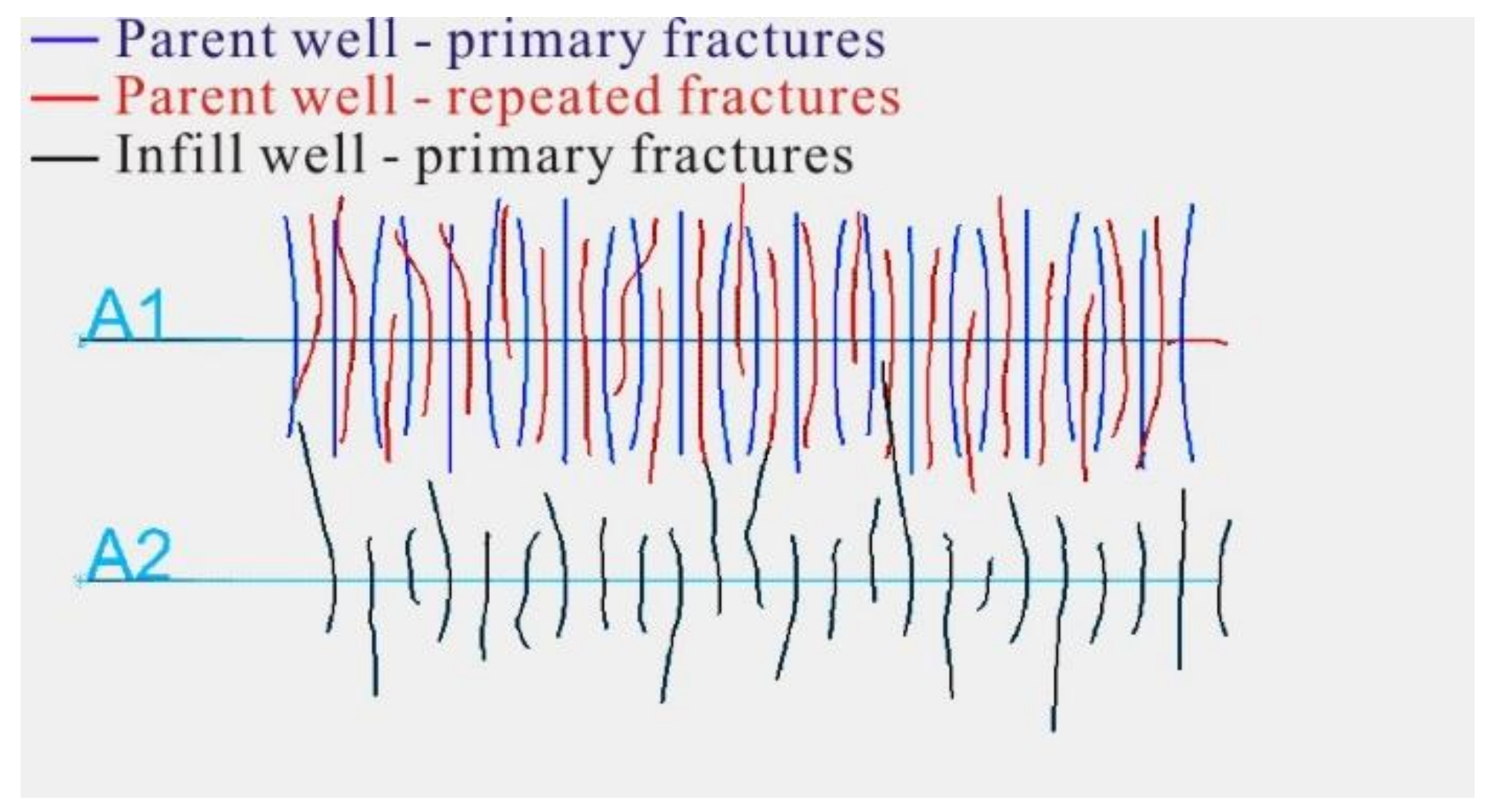
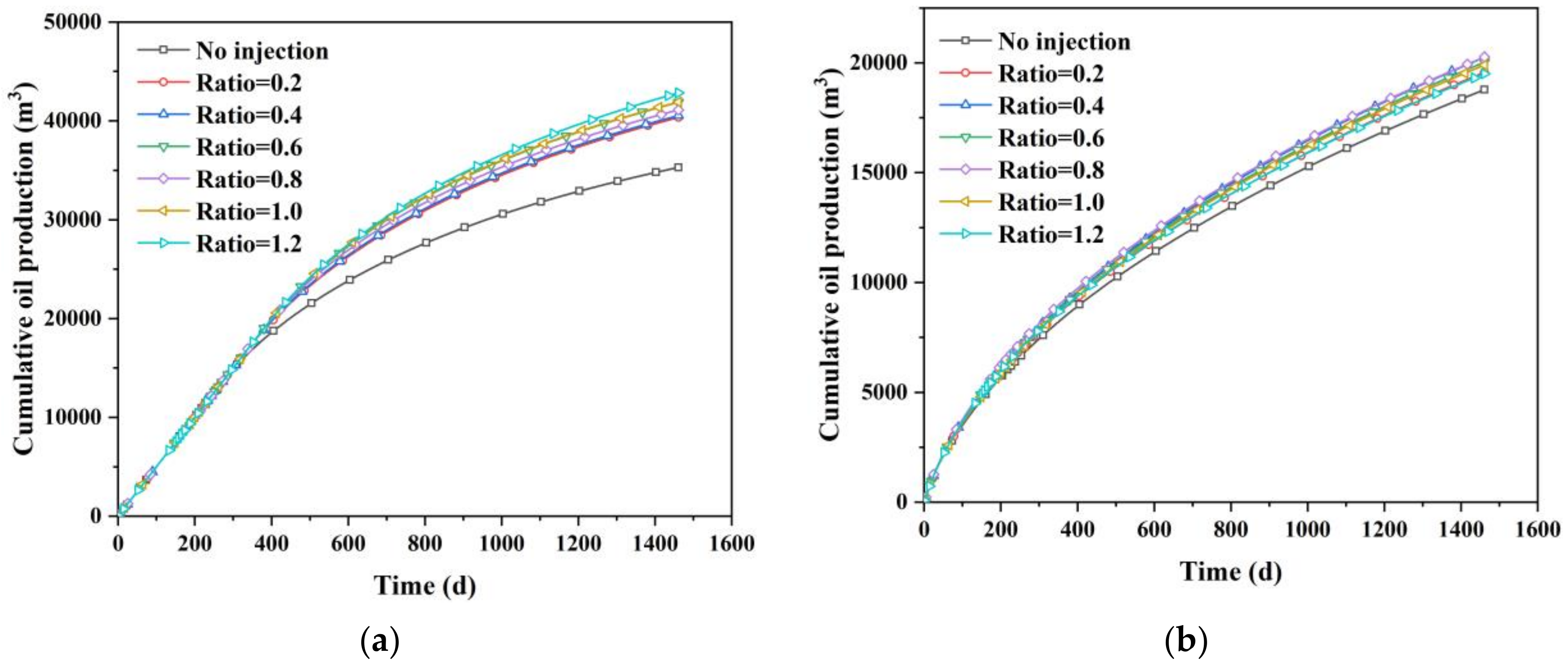
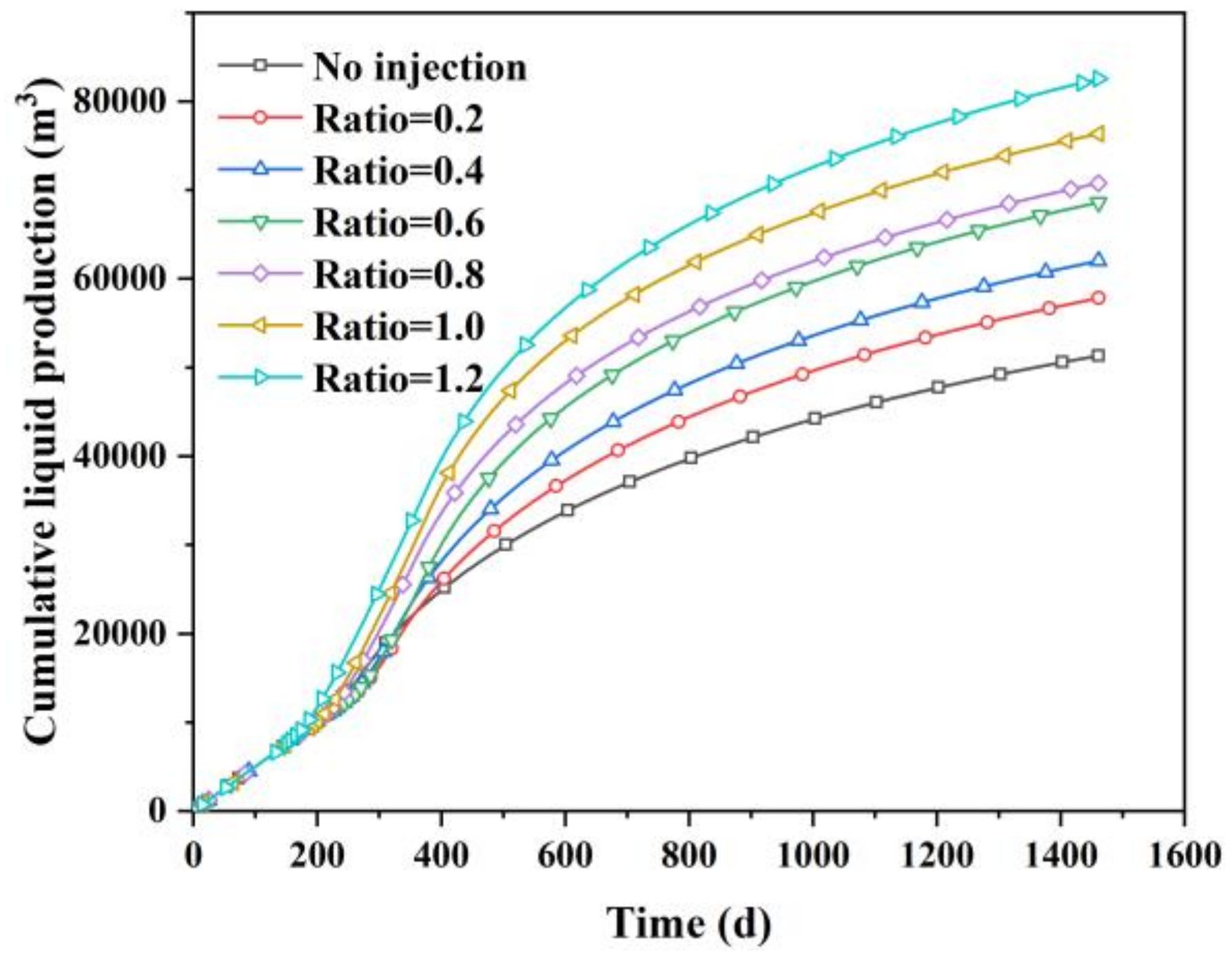
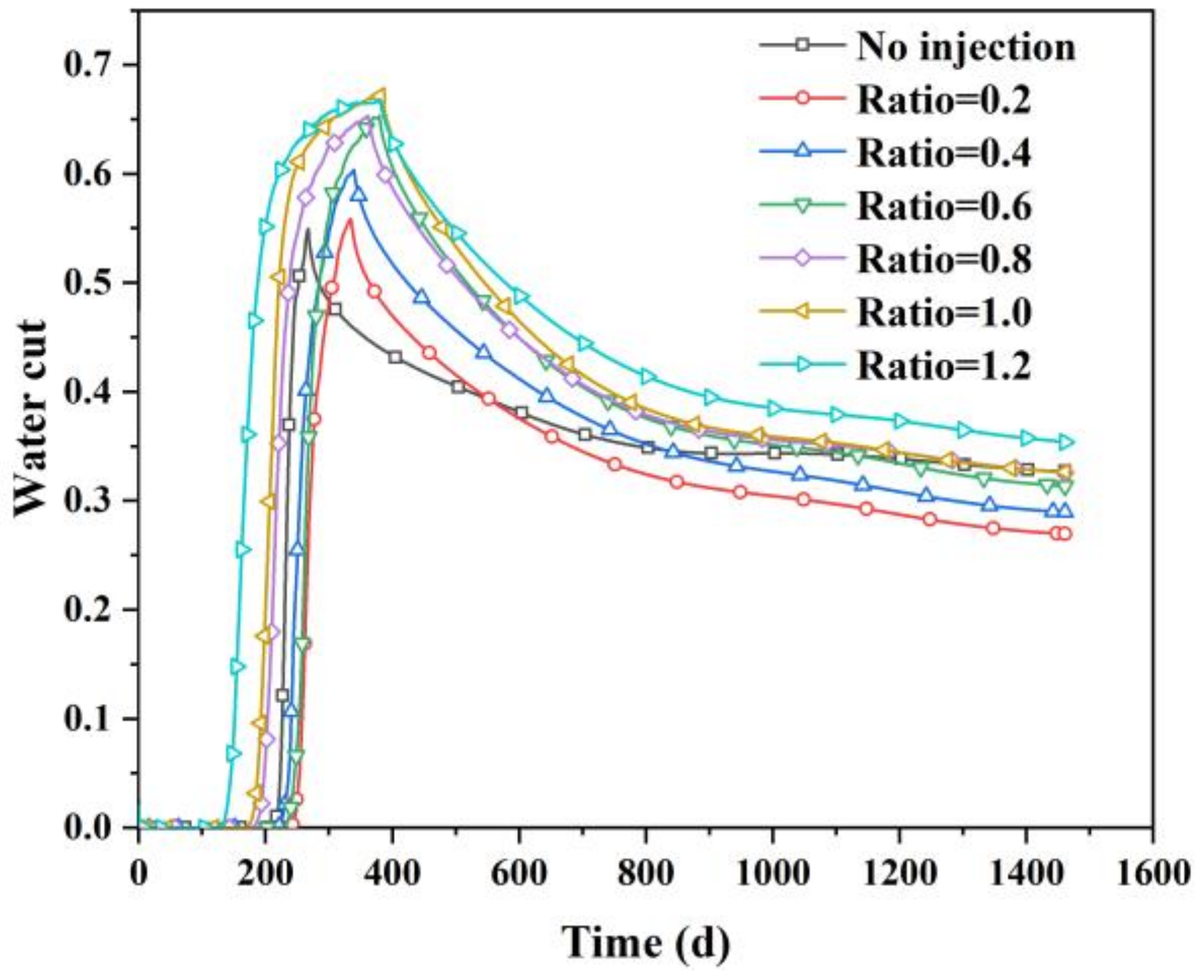
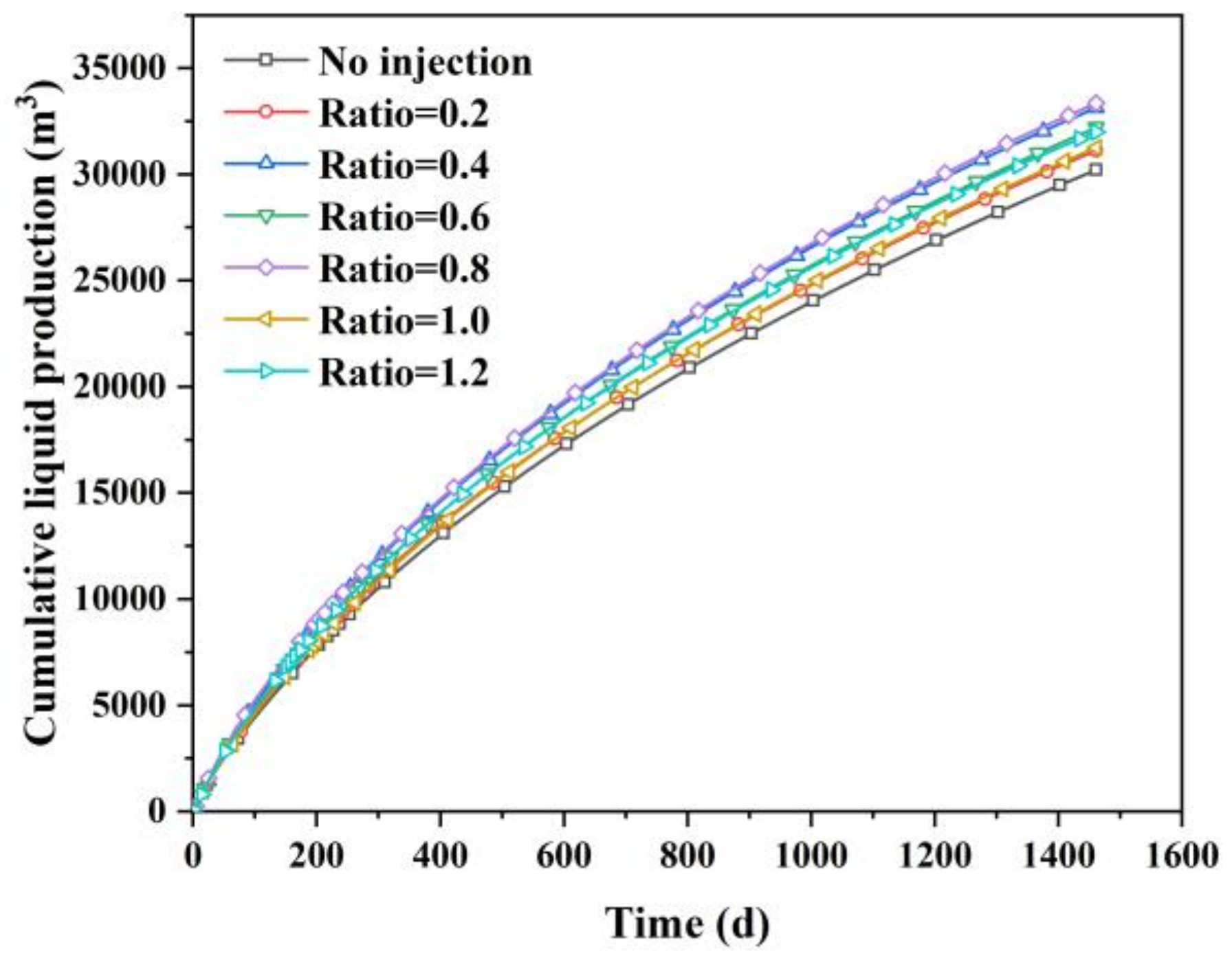



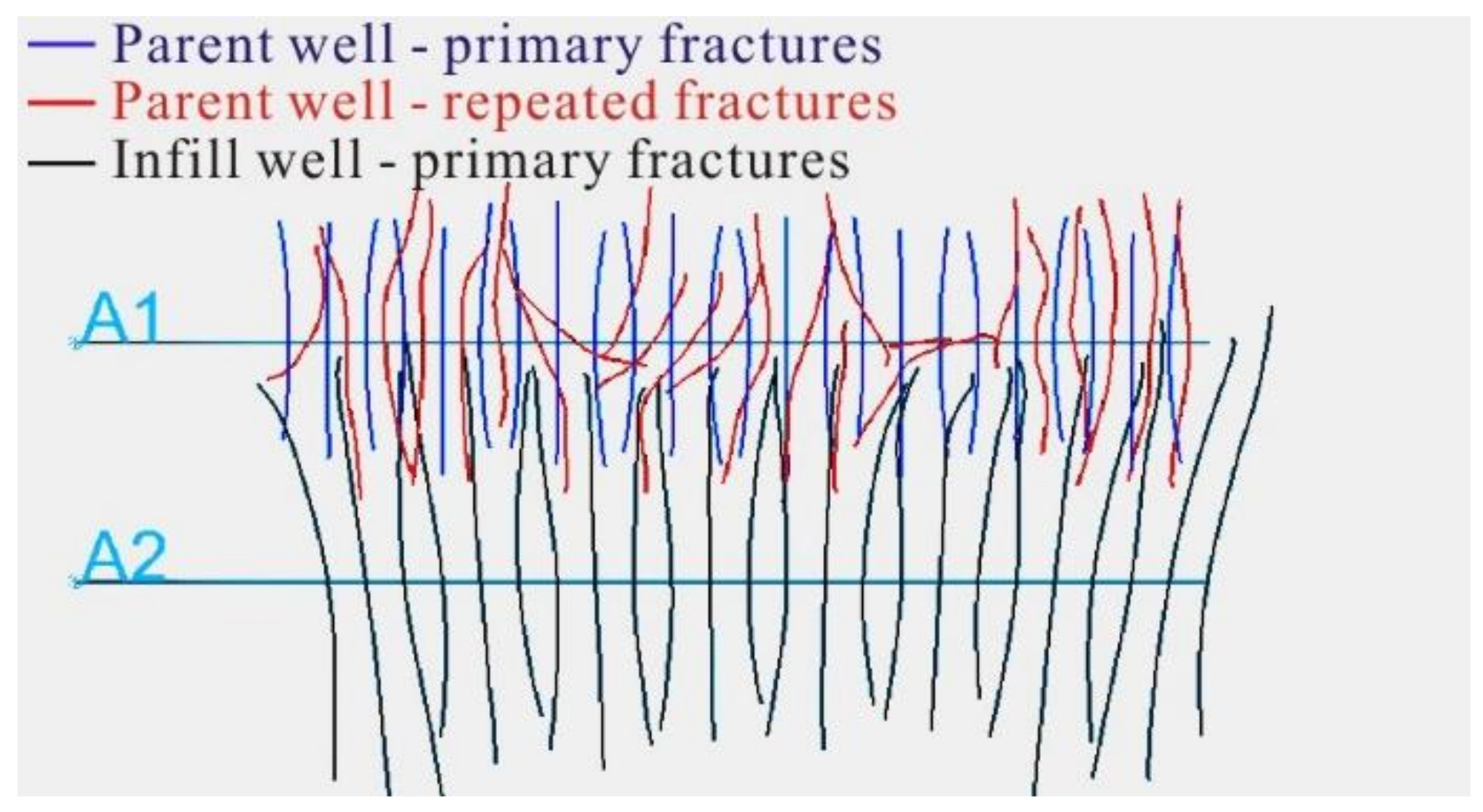
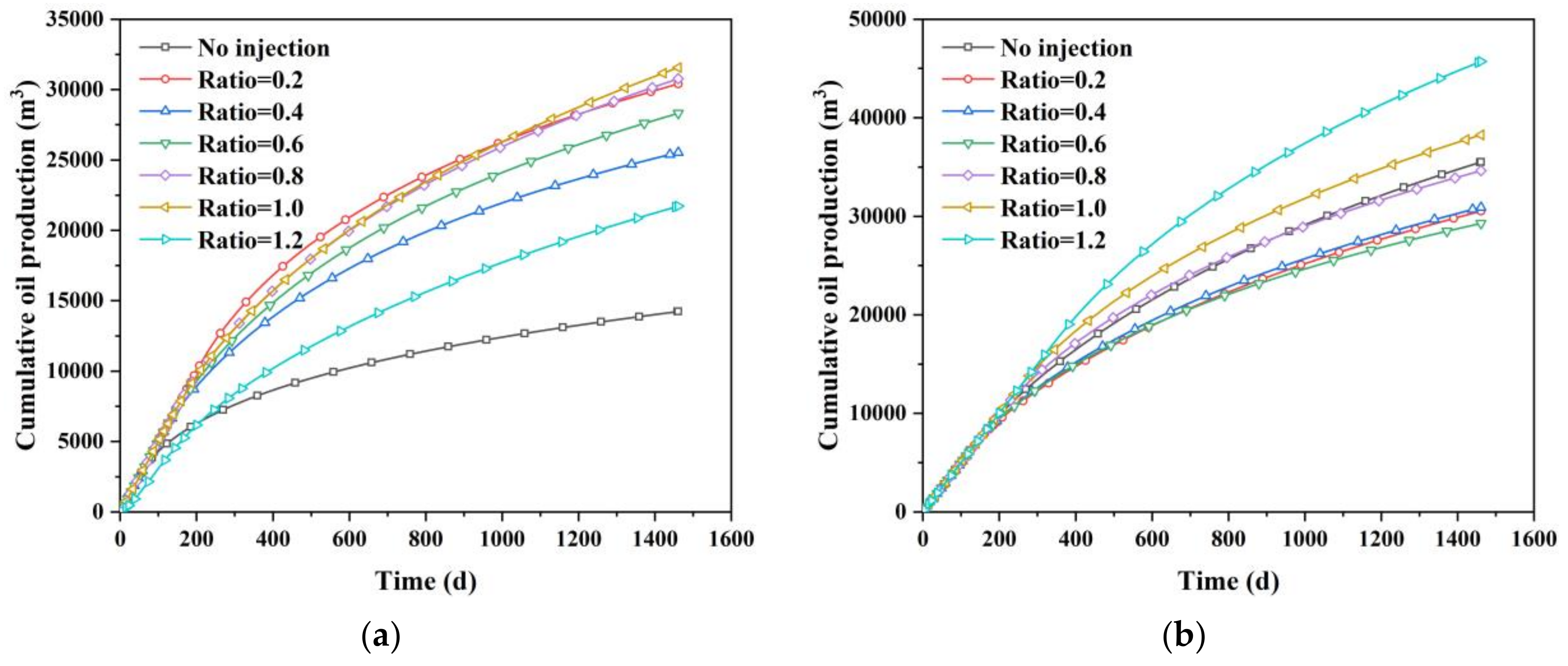
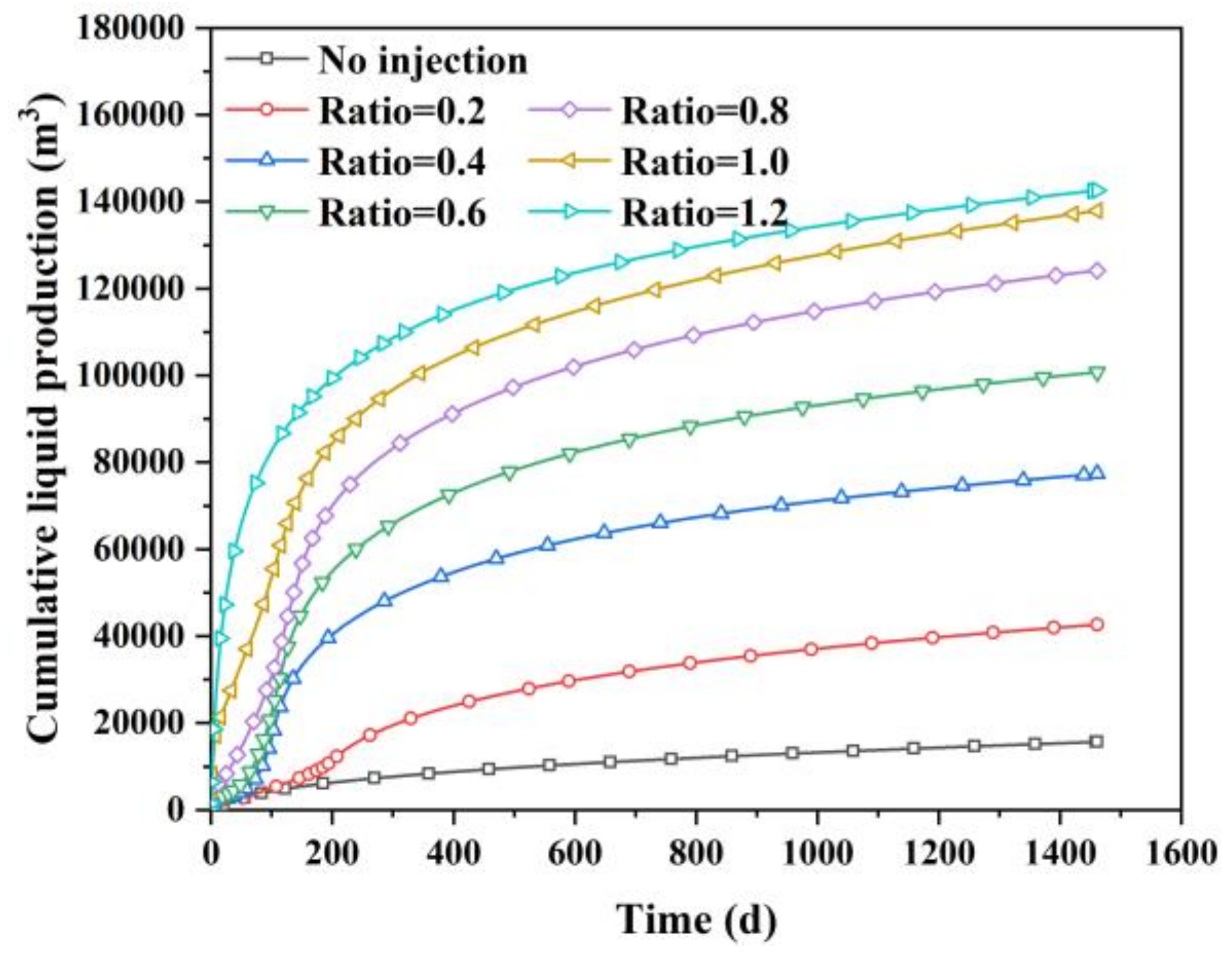
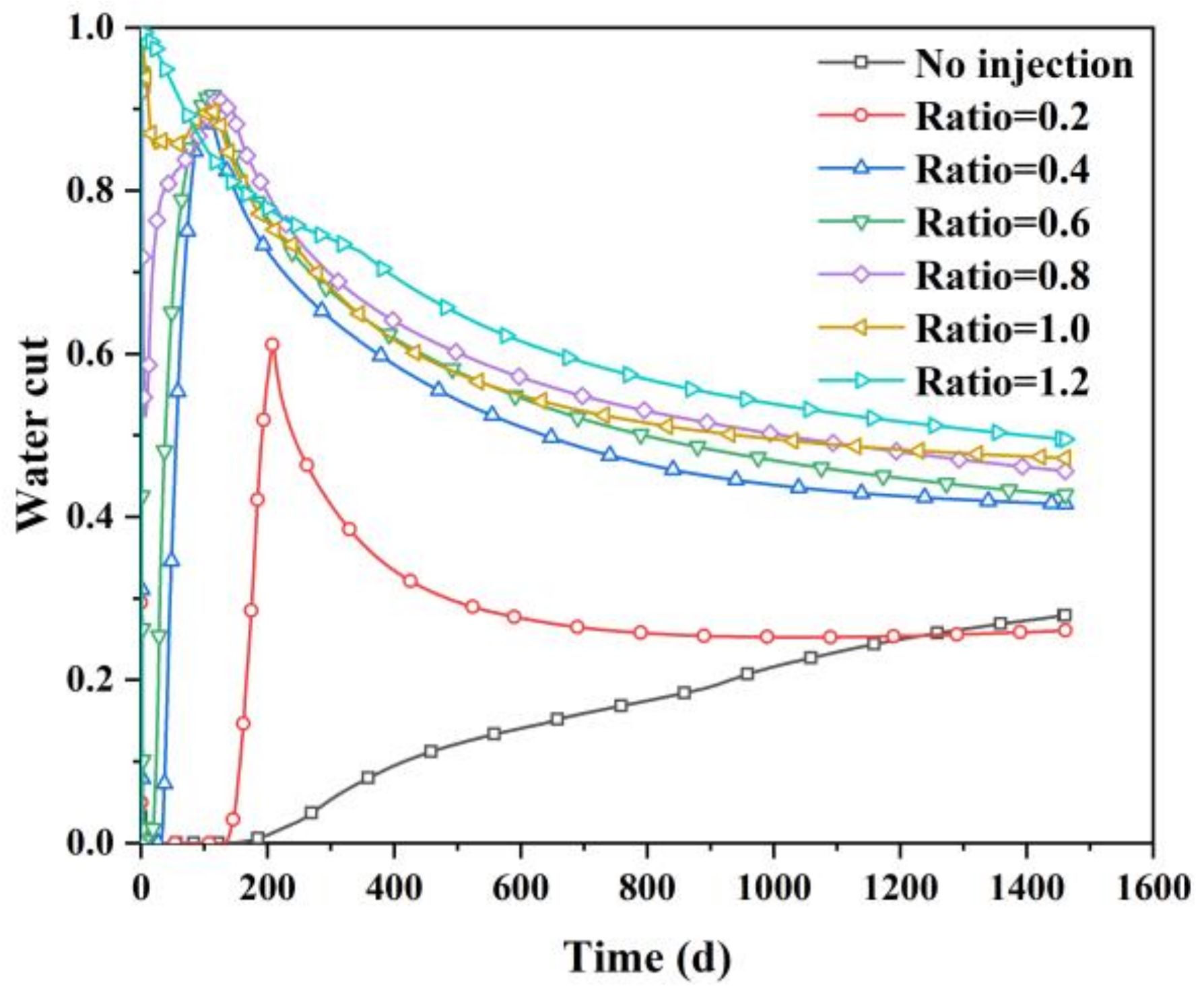
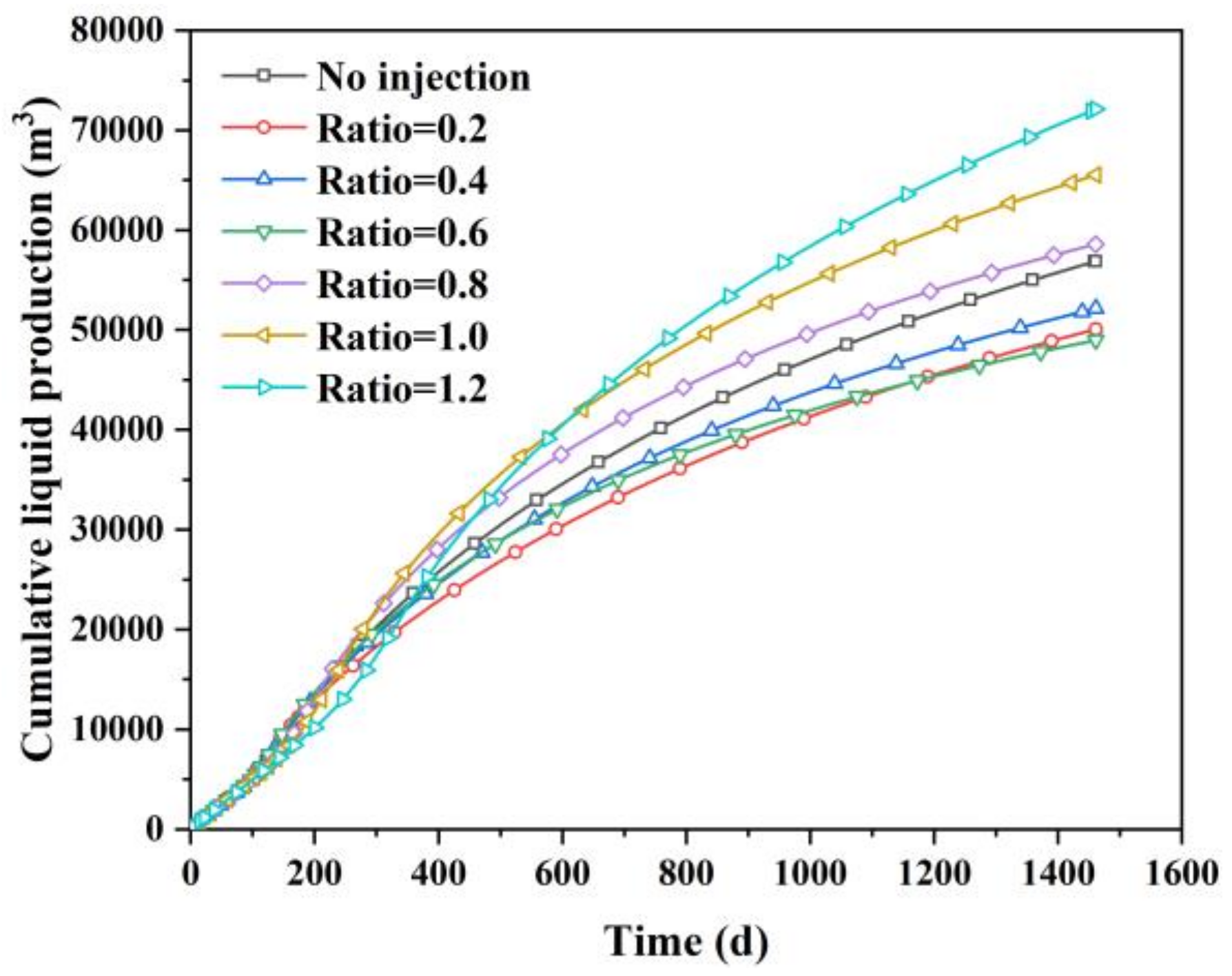


| Parameters | Values | Parameters | Values |
|---|---|---|---|
| Matrix permeability, mD | 0.01 | Minimum horizontal principal stress, MPa | 45 |
| Matrix porosity | 0.1 | Maximum horizontal principal stress, MPa | 55 |
| Initial reservoir pressure, MPa | 39 | Overburden stress, MPa | 60 |
| Initial oil saturation | 0.5 | Young’s modulus, GPa | 35 |
| Reservoir thickness, m | 200 | Poisson’s ratio | 0.3 |
| Bubble-point pressure, MPa | 15 | Tensile strength, MPa | 5 |
| Total compressibility, kPa−1 | 2 × 10−6 | Reservoir temperature, °C | 85 |
Publisher’s Note: MDPI stays neutral with regard to jurisdictional claims in published maps and institutional affiliations. |
© 2022 by the authors. Licensee MDPI, Basel, Switzerland. This article is an open access article distributed under the terms and conditions of the Creative Commons Attribution (CC BY) license (https://creativecommons.org/licenses/by/4.0/).
Share and Cite
Ren, G.; Ma, X.; Zhang, S.; Zou, Y.; Duan, G.; Xiong, Q. Optimization of Water Injection Strategy before Re-Stimulation Considering Fractures Propagation. Processes 2022, 10, 1538. https://doi.org/10.3390/pr10081538
Ren G, Ma X, Zhang S, Zou Y, Duan G, Xiong Q. Optimization of Water Injection Strategy before Re-Stimulation Considering Fractures Propagation. Processes. 2022; 10(8):1538. https://doi.org/10.3390/pr10081538
Chicago/Turabian StyleRen, Guangcong, Xinfang Ma, Shicheng Zhang, Yushi Zou, Guifu Duan, and Qiyong Xiong. 2022. "Optimization of Water Injection Strategy before Re-Stimulation Considering Fractures Propagation" Processes 10, no. 8: 1538. https://doi.org/10.3390/pr10081538
APA StyleRen, G., Ma, X., Zhang, S., Zou, Y., Duan, G., & Xiong, Q. (2022). Optimization of Water Injection Strategy before Re-Stimulation Considering Fractures Propagation. Processes, 10(8), 1538. https://doi.org/10.3390/pr10081538






